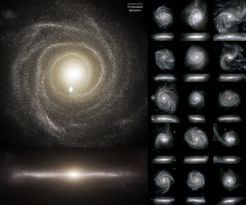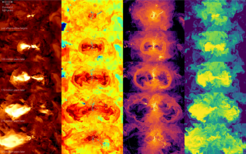Cosmic carousels
The new cosmological simulation TNG50 shows how the universe evolved and order gradually emerged from chaos
Galaxies are considered to be the largest building blocks in the universe. But how were they born? How did they evolve? In order to get closer to the answers to these questions, an international team of scientists - including researchers from the Max Planck Institutes for Astronomy and Astrophysics - packed space into the computer. The result is Illustris TNG50, the most detailed large-scale cosmological simulation to date. For the first time, it reveals that the geometry of the cosmic gas flows around galaxies determines galaxy structure, and vice versa. Conversely, the properties of the gas flows result from the evolution of the galaxies.

Simulated Milky Ways: images of disk galaxies from the TNG50 simulation in visible light. For each galaxy, there is a face-on view (top) and an edge-on view. TNG50 has thrown new light on how disk galaxies like this form.
Astronomers running cosmological simulations face a fundamental trade-off: with finite computing power, typical simulations so far have been either very detailed or have spanned a large volume of virtual space, but not both. Detailed simulations with limited volumes can model no more than a few galaxies, making statistical deductions difficult. Large-volume simulations, in turn, typically lack fine details on smaller scales, which are important for describing individual galaxies. The TNG50 simulation, which has just been published, manages to avoid this trade-off. For the first time, it combines the idea of a large-scale cosmological simulation – a Universe in a box – with the computational resolution of “zoom” simulations, at a level of detail that had previously only been possible for studies of individual galaxies.
In a simulated cube of space that is more than 230 million light-years across, TNG50 can discern physical phenomena that occur on scales one million times smaller, tracing the simultaneous evolution of thousands of galaxies over 13.8 billion years of cosmic history. It does so with more than 20 billion particles representing dark matter, stars, cosmic gas, magnetic fields, and supermassive black holes. The calculation itself required 16,000 cores on the Hazel Hen supercomputer in Stuttgart working together, 24/7, for more than a year – the equivalent of fifteen thousand years on a single processor, making it one of the most demanding astrophysical computations to date.
The first scientific results from TNG50, presented in two articles that have just been published in the Monthly Notices of the Royal Astronomical Society, by a team led by Annalisa Pillepich (Max Planck Institute for Astronomy, Heidelberg) and Dylan Nelson (Max Planck Institute for Astrophysics, Garching), have revealed unforeseen physical phenomena. According to Nelson: “Numerical experiments of this kind are particularly successful when you get out more than you put in. In our simulation, we see phenomena that had not been programmed explicitly into the simulation code. These phenomena emerge in a natural fashion, from the complex interplay of the basic physical ingredients of our model universe.”
TNG50 features two prominent examples for this kind of emergent behavior. The first concerns the formation of “disk” galaxies like our own Milky Way. Using TNG50 as a time machine to rewind the evolution of cosmic structure, researchers have seen how the well-ordered, rapidly rotating disk galaxies (which are common in our nearby Universe) emerge from chaotic, disorganized, and highly turbulent clouds of gas at earlier epochs.

Outflow of gas from a galaxy. From top to bottom, each row represents a different snapshot, spanning 370 million years of cosmic evolution. The outflow is driven by energy set free near the active supermassive black hole in the galaxy’s center. From left to right, the columns show false-color representations of the velocity, temperature, density and heavy element content of the galaxy. The galaxy itself is the cold (blue, second column from left) and dense (yellow, third column) disk of star-forming gas visible as a small, vertical structure in the center of each image.
As the gas settles down, newborn stars are typically found on more and more circular orbits, eventually forming large spiral galaxies – galactic carousels. Annalisa Pillepich explains: “In practice, TNG50 shows that our own Milky Way galaxy with its thin disk is at the height of galaxy fashion: over the past 10 billion years, at least those galaxies that are still forming new stars have become more and more disk-like, and their chaotic internal motions have decreased considerably. The Universe was much more messy when it was just a few billion years old!”
As these galaxies flatten out, researchers found another emergent phenomenon, concerning high-speed outflows and winds of gas flowing out of galaxies. Such outflows and winds are launched as a result of supernovae explosions and supermassive black hole activity. Galactic gaseous outflows are initially also chaotic and flow away in all directions, but over time, they begin to become more focused along a path of least resistance. In the late universe, outflows are oriented within two conical volumes, emerging from the galaxy in opposite directions – like two ice cream cones placed tip to tip, with the galaxy swirling at the center.
These winds slow down as they attempt to leave the gravitational well of the dark matter halo, and can eventually stall and fall back onto the galaxies, forming a galactic fountain of recycled gas. This process redistributes gas from the center of a galaxy to its outskirts, further accelerating the transformation of the galaxy itself into a thin disk: galactic structure shapes galactic fountains, and vice versa.
Just as for the other simulations of the TNG family, the team of scientists creating TNG50 (based at Max Planck Institutes in Heidelberg and Garching, Harvard University, MIT, and the CCA) will eventually release all simulation data to the astronomy community at large and to the public. Then, astronomers all over the world will be able to make their own discoveries in the TNG50 universe – and possibly find additional examples of emergent cosmic phenomena, of order emerging from chaos.
MP / HOR













